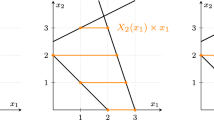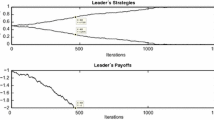Abstract
In view of the core optimization, this paper establishes a new associated game starting from one with a nonempty core and proposes a sequence of associated games recursively. We prove that the cores of the associated games are increasingly stable in two aspects. Firstly, the core of each game is contained in the one it precedes. Secondly, any allocation outside the core of the corresponding associated game is indirectly dominated by a certain allocation in it. Therefore, the last one of the nonempty cores in this sequence is the final optimized set. More interestingly, if this sequence does not encounter a game with an empty core, we show that it converges and that the limit game is a constant-sum one by the matrix approach. In this case, we can ideally select a unique point from the core of the original game, which is the core of such a limit game.



Similar content being viewed by others
Notes
Hamiache [4] gives an interpretation for his associated game. A coalition may believe that the appropriation of at least a part of the surpluses, generated by its cooperation with each one of the isolated players in its complementary coalition, is within reach. As a consequence, this coalition may revaluate its own worth as the summation of its worth in the original game and of a uniform percentage of all the possible previous surpluses.
Coalition \(S = \left\{ {{i_1},{i_2}, \ldots ,{i_s}} \right\} \) with \(i_1< i_2< \cdots < i_s\) precedes coalition \(T = \left\{ {{j_1},{j_2}, \ldots ,{j_t}} \right\} \) with \(j_1< j_2< \cdots < j_t\), if and only if the sizes of these two coalitions verify either \(s < t\), or \(s = t\) and for some k, \(1 \le k <s\), it holds that \(i_l = j_l\) for \(1 \le l< k\) and \(i_k < j_k\).
The efficient Aumann–Drèze value is a normalization of the Aumann–Drèze value via weighted Shapley value [20]. The efficient Myerson value is a normalization of the Myerson value via the same weighted Shapley value. As expected, they verify the efficiency property: Given a game \(\left( N,v\right) \in G^N\), a value \(\varphi \in \mathrm{I\!R}^n\) is efficient, if \(\sum \limits _{i\in N}{\varphi _i} = v\left( N\right) \).
In order to investigate the expression of the limit game, they point out that \(v^{Sh}_k\left( S\right) \) can be expressed as a linear combination of \(v\left( S\right) , v\left( N\right) \) and \(v\left( N\backslash S\right) \), that is,
$$\begin{aligned} v^{Sh}_k\left( S\right) = \gamma _kv\left( S\right) +\alpha _kv\left( N\right) + \beta _kv\left( N\backslash S\right) ,\end{aligned}$$where \(\gamma _k,\alpha _k,\beta _k\in \mathrm{I\!R}\).
References
Gillies, D.B.: Some theorems on \(n\)-person games. In: Ph.D. Thesis. Princeton University, Department of Mathematics, Princeton University Press, Princeton (1953)
Shapley, L.S., Shubik, M.: Quasi-cores in a monetary economy with nonconvex preferences. Econom.: J. Econom. Soc. 34(4), 805–827 (1966)
Maschler, M., Peleg, B., Shapley, L.S.: Geometric properties of the kernel, nucleolus, and related solution concepts. Math. Oper. Res. 4(4), 303–338 (1979)
Hamiache, G.: Associated consistency and Shapley value. Int. J. Game Theory 30(2), 279–289 (2001)
Hwang, Y.A., Julia, R., Ismail, R.: Union negotiations: complement-associated games. Oper. Res. Lett. 45(2), 126–132 (2017)
Xu, G., Driessen, T.S.H., Sun, H.: Matrix analysis for associated consistency in cooperative game theory. Linear Algebra Appl. 428(7), 1571–1586 (2008)
Schmeidler, D.: The nucleolus of a characteristic function game. SIAM J. Appl. Math. 17(6), 1163–1170 (1969)
Nguyen, T.D.: The fairest core in cooperative games with transferable utilities. Oper. Res. Lett. 43(1), 34–39 (2015)
González-Díaz, J., Sánchez-Rodríguez, E.: A natural selection from the core of a TU game: the core-center. Int. J. Game Theory 36(1), 27–46 (2007)
von Neumann, J., Mogenstern, O.: Theory of Games and Economic Behavior. Princeton University Press, Princeton (1953)
Sengupta, A., Sengupta, K.: A property of the core. Games Econ. Behav. 12(2), 266–273 (1996)
Charnes, A., Rousseau, J., Seiford, L.: Complements, mollifiers and the propensity to disrupt. Int. J. Game Theory 7(1), 37–50 (1978)
Shapley, L.S.: A value for \(n\)-person games. Ann. Math. Stud. 28, 307–317 (1953)
Dragan, I.: The potential basis and the weighted Shapley value. Lib. Math. 11, 139–150 (1991)
Dragan, I.: New mathematical properties of the Banzhaf value. Eur. J. Oper. Res. 95(2), 451–463 (1996)
Yokote, K., Funaki, Y., Kamijo, Y.: A new basis and the Shapley value. Math. Soc. Sci. 80, 21–24 (2016)
Xu, G., Driessen, T.S.H., Sun, H.: Matrix approach to dual similar associated consistency for the Shapley value. Linear Algebra Appl. 430(11), 2896–2897 (2009)
Hamiache, G.: A matrix approach to the associated consistency with an application to the Shapley value. Int. Game Theory Rev. 12(2), 175–187 (2010)
Hamiache, G.: A matrix approach to TU games with coalition and communication structures. Soc. Choice Welf. 38(1), 85–100 (2012)
Kalai, E., Samet, D.: On weighted Shapley values. Int. J. Game Theory 16(3), 205–222 (1987)
Xu, G., van den Brink, R., van der Laan, G., Sun, H.: Associated consistency characterization of two linear values for TU games by matrix approach. Linear Algebra Appl. 471, 224–240 (2015)
Driessen, T.S.H., Funaki, Y.: Coincidence of and collinearity between game theoretic solutions. Oper. Res. Spektrum 13, 15–30 (1991)
Shapley, L.S., Shubik, M.: Ownership and the production function. Q. J. Econ. 81(1), 88–111 (1967)
Chetty, V.K., Dasgupta, D., Raghavan, T.E.S.: Power and distribution of profits. In: Discussion Paper No. 139. Indian Statistical Institute, Delhi Centre, New Delhi (1976)
Acknowledgements
We are very grateful to the editor and two anonymous referees. Their valuable comments and suggestions contribute to a substantial improvement of the paper. We are also very grateful to Dr. Moses Olabhele Esangbedo, who helps us improve the use of English language. This work is supported by National Natural Science Foundation of China (Grant Nos. 71571143, 71671140, 71601156 and 71871180) and sponsored by Innovation Foundation for Doctor Dissertation of Northwestern Polytechnical University.
Author information
Authors and Affiliations
Corresponding author
Additional information
Communicated by Kyriakos G. Vamvoudakis.
Publisher's Note
Springer Nature remains neutral with regard to jurisdictional claims in published maps and institutional affiliations.
Rights and permissions
About this article
Cite this article
Kong, Q., Sun, H., Xu, G. et al. Associated Games to Optimize the Core of a Transferable Utility Game. J Optim Theory Appl 182, 816–836 (2019). https://doi.org/10.1007/s10957-019-01494-y
Received:
Accepted:
Published:
Issue Date:
DOI: https://doi.org/10.1007/s10957-019-01494-y




